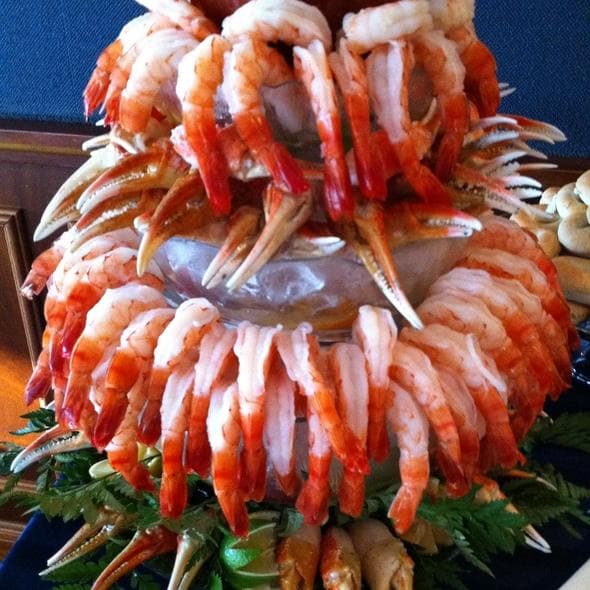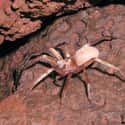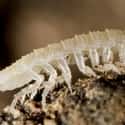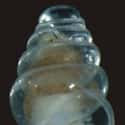-
(#8) Unlike Their Land-Dwelling Relatives, Kaua'i Cave Wolf Spiders Have No Eyes
This native of Hawaii was discovered in 1973, and has since then only been found living in a few caves in the Koloa District of Kaua‘i. The cave wolf spider is closely related to wolf spiders that dwell on land above it, but whereas the surface-dwellers have large eyes and acute vision, the cave-dwellers have lost their eyes completely. They don't need physical camouflage to hide from prey so they have lost much of their pigmentation. They are venomous, but only dangerous to small prey animals. The cave species is endangered due to its limited habitat, but the US Fish & Wildlife Service started a 34-acre preserve to protect the population.
-

(#4) Phantom Cave Snails Are Completely White - Unlike Their Non-Cave Relatives
Phantom cave snails are cave-dwelling relatives of freshwater gastropods known as springsnails, native to a small series of caves in the vicinity of Balmorhea, TX. Like many subterranean creatures, phantom cave snails are blind and have abandoned the use of pigment in their bodies so they appear pale white or transparent. They also have more convex shell whorls than their terrestrial relatives, longer umbilicus, and a simple penis. Due to their existence being dependent upon three small springs, the phantom cave snail is considered to be a critically imperiled species.
-
(#15) Cave Loach Are Half The Size Of Their Surface Friends
While there are an estimated 200 species of cave-dwelling fish around the world, cave loach living in the Danube-Aach cave system in Southern Germany is the first ever instance of a troglophilic fish in Europe. It is believed the cave loach separated from its terrestrial relatives as many as 20,000 years ago. The cave loach's body is similar in structure to a surface loach except that much of its pigmentation has disappeared, giving it a translucent pink hue. The cave loach has retained its eyes, but they shrunk to half the size of a surface loach and "they don't react" to light, so scientists are not even sure they are functional.
-
(#6) The Mexican Blind Cavefish Looks Different Than Its Fish Relatives, But Can Still Reproduce With Them
Found in caves throughout Mexico and the southern United States, the Astyanax mexicanus, commonly called the Mexican blind cavefish, can co-exist with and still reproduce with its surface-water relatives, even though it has become heavily mutated and modified from years in total darkness. To conserve energy, Mexican blind cavefish have lost their eyes and the vision center of their brains, as well as their pigmentation; their scales have become translucent. The Mexican blind cavefish have adapted to being blind by having taste buds that grow on the outside of their lower jaws, which help them taste the water around them for food.
-
(#7) The Cave Woodlouse Has Zero Pigment Or Eyes
The cave woodlouse was found in a pretty crazy place - a cave that was isolated for more than 5 million years. The cave, located in southeastern Romania near the Black Sea, has one the rarest ecosystems in the world. That's because it's been undisturbed by outside influences, including sunlight, for so long that the creatures within have developed some pretty unusual adaptations. It's hot and humid in the cave, low in oxygen, and the water at the bottom is warm and sulphidic, giving the cave a putrid, rotting eggs smell. A human being could only survive in the cave without breathing apparatus "for five or six hours before their kidneys" shut down.
The cave is covered by a thick layer of clay that prevents fresh water from seeping down into it, but the environment is perfect for the growth of a type of bacteria called "autotrophs" that grows in large floating mats of frothy foam atop the fetid water. And another bacteria called "methantrophs" that derives energy and carbon from methane gas bubbles. All creatures in the cave system feed off of this bacteria, including the cave woodlouse, which has adapted to life in total darkness by sacrificing its pigmentation - there's no need for camouflage or sexual displays in the dark - and its eyes.
-
(#13) The Transparent Snail Has A See-Through Shell
This cave-dwelling gastropod was discovered in 2012. It's blind and has a transparent body just like the phantom cave snail; however, it has also adapted to cave life by eliminating pigment in its shell. Discovered living more than 3,000 feet (914 meters) beneath the ground in a cave in Croatia, the transparent snail has also adapted to the lack of nutrients at those depths by being an incredibly slow mover, even for snails. They "only creep a few millimeters or centimeters a week, and mainly in circles, grazing" in the same place.
New Random Displays Display All By Ranking
About This Tool
The hidden and deep caves have unique environmental conditions that make the life of creatures mysterious and challenging. Many cave environments are in constant darkness and high humidity, and it is difficult for animals to absorb nutrients and even full of gases such as sulfur and methane mixtures that are lethal to most organisms. However, there are still many cave-dwelling creatures who have evolved and adapted to live in these gloomy, dark environments.
Insects, fish, and crustaceans can penetrate into mysterious caves all over the earth, perhaps the most well-known cave dwellers are bats. Here the random tool introduced 15 fascinating skills of cave-dwelling creatures.
Our data comes from Ranker, If you want to participate in the ranking of items displayed on this page, please click here.














